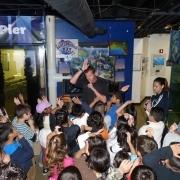Editor’s note: Nick Fash is one of two teachers at the Santa Monica Pier Aquarium. He and colleague Aaron Kind educate as many as 600 students in a week. Nick chronicles a day in the life of an Aquarium education specialist.
Entering the Aquarium first thing in the morning, flipping on the lights, the quiet tranquility is only broken by the soothing sound of water flowing through pipes. This will all change in one short hour when 60 excited children will fill this space with ohhs, ahhs and countless wide-eyed questions. But many things need to get done over the next 60 minutes in order for those children to have “one of the best days ever!”
Checking the schedule, noting the age of the students, their number and the topic for the class, Aaron and I begin to formulate our plan. We have been doing this for years and can effortlessly communicate the details: setting up the hands-on lab, placing the whale bones out, matching the signage to the different marine mammal skulls on display and prepping the classroom with the correct number of tables and chairs. By the time the covers are removed from the touch tanks, we are ready to prep our wonderful education docents on what we will need from them and when we will need it done. We are lucky to have such a devoted team backing us up, as 60 energized students is quite a handful for just the two of us.
We swing open the patio doors, letting the ocean air into the Aquarium and go about hanging the kelp forest barriers that effectively create a private outdoor addition to our space. And just in time, a big yellow school bus rumbles to a stop outside of our front door, every window lined with faces, with eyes as wide as can be.
Greeting the teachers we confirm the details and run them through our plan. As the students gather at the front door, I give the excited students a quick walk through of the rules and the expectations we have for our young ”scientists,” and as I swing the doors open I must watch my toes as the children eagerly flow into the Aquarium. Many hands are in the touch tanks, all the while rattling off questions at a dizzying pace. A group of students learns about sharks around our open top shark exhibit, while others have their faces pressed up against the glass of the sea jelly exhibit. Twenty minutes later we split our group into two small teams.
One group lines up with Aaron by the front door, where they will be heading for the beach to discover animals in their natural habitat and to learn about impacts of pollution on the sandy beach environment. The other half tiptoes into the Green Room where we have live tide pool animals ready for them to really get to know. As they sit quietly on the floor, their eyes fixed upon me, wondering what I am going to say, I begin. “Where do all of my animals come from?” As we learn about habitats, whales, sea stars, sea urchins, sea cucumbers and a host of other animals from our local waters, I remind them that they are our neighbors and if we keep our neighborhoods clean, their home will be clean as well.
But the radio belches out Aaron’s 3-minute warning, and I line up the students for our turn at the beach. As we pass Aaron and his group on the way in, the students swap excited stories of what they had just experienced, but the beach awaits. Sand crabs, bean clams, kelp, birds and the occasional dolphin or sea lion can all be expected while we dig through the sand and explore the beach in a way many of these children have never done before.
As we line the students up to clean their hands and gather their belongings, we are already mentally prepping for our next class, as we have just 30 minutes before we do this all over again. Thank you coffee.
photos by Maita Moura





